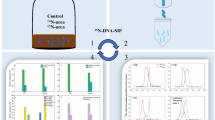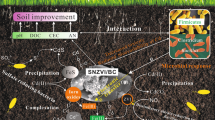Abstract
The influence of six nitrification inhibitors (NI) on CH4 production in an alluvial soil under flooded condition was studied in a laboratory incubation experiment. The inhibition of CH4 production followed the order of sodium azide > dicyandiamide (DCD) > pyridine > aminopurine > ammonium thiosulfate > thiourea. Inhibition of CH4 production in DCD-amended soils was related to a high redox potential, low pH, low Fe2+ and lower readily mineralizable carbon content as well as lower population of methanogenic bacteria and their activity. In the presence of higher levels of urea N (40 μg), the inhibitory effect of DCD was only partially alleviated. Results indicate that several NIs can differentially regulate CH4 production in a flooded alluvial soil.
Similar content being viewed by others
References
Adhya TK, Pattnaik P, Satpathy SN, Kumaraswamy S & Sethunathan N (1998) Influence of phosphorus application on methane emission and production in flooded paddy soils. Soil Biol Biochem 30:177–181
Alexander M (1982) Most probable number method for microbial population. In: Page AL, Miller RH & Keeney DR (eds) Methods of Soil Analysis, Part 2, Chapter 46, pp 815–1009, American Society of Agronomy, Madison, Wisconsin
Anastasi C, Dowding M & Simpson VJ (1992) Future CH4 emissions from rice production. J Geophys Res 97:7521–7525
Aulakh MS & Rennie DA (1985) Azide effects upon N2O emission and transformations of N in soils. Can J Soil Sci 65:205–212
Bollag JM & Czlonkowski ST (1973) Inhibition of methane formation in soil by various nitrogen-containing compounds. Soil Biol Biochem 5:673–678
Bouwman AF (1990) Exchange of greenhouse gases between terrestrial ecosystems and the atmosphere. In: Bouwman AF (ed) Soils and the Greenhouse Effect, pp 61–192, John Wiley & Sons, New York
Bharati K, Mohanty SR, Adhya TK, Banerjee A, Rao VR & Sethunathan N (1999) Influence of a commercial formulation of tridemorph on methane production and oxidation in a tropical rice soil. Chemosphere 39:933–943
Bremner JM & Yeomans JC (1986) Effects of nitrification inhibitors on denitrification of nitrate in soil. Biol Fertil Soils 2:173–179
Bronson KF & Mosier AR (1991) Effect of encapsulated calcium carbide on dinitrogen, nitrous oxide, methane and carbon dioxide emissions from flooded rice. Biol Fertil Soils 11:116–120
Cicerone RJ & Shetter JD (1981) Sources of atmospheric methane: measurements in rice paddies and a discussions. J Geophys Res 86:7203–7209
Conrad R (1996) Soil microorganisms as controllers of atmospheric trace gases (H2, CO, CH4, OCS, N2O and NO). Microbiol Rev 60:28–32.
Gorelik LA, Yanishevskii FV, Podkolzina CV, Golov VG & Yashinevsky FV (1992) Efficiency of the nitrification inhibitor dicyandiamide in field experiments of the NIUIF geo-network. Agrokhimiya 9:14–18
Hanson RS & Hanson TE (1996) Methanotrophic bacteria. Microbiol Rev 60:439–471.
Hauck RD (1984) Technological approaches to improving the efficiency of nitrogen fertilizer use by crop plants. In: Hauck RD (ed) Nitrogen in Crop Production, pp 551–560, American Scociety of Agronomy, Madison, Wisconsin
Houghton JT, Callander BA & Varney SK (1992) Intergovernmental Panel on Climatic Change (IPCC) 1992: Climate change. The supplementary report to the IPCC Scientific Assessment, pp 1–200, Cambridge University Press, New York
IRRI (International Rice Research Institute) (1999) Sustaining Food Security Beyond the Year 2000-A Global Partnership for Rice Research: Medium-term Plan 2000-2002, p 130, International Rice Research Institute, Los Banos, Philippines
Kasper HF & Tiedje JM (1982) Anaerobic bacteria and processes. In: Page AL, Miller RH and Keeney DR (eds) Methods of Soil Analysis, Part 2, Chapter 46, pp 989–1009, American Scociety of Agronomy, Madison, Wisconsin
Keerthisinghe DG, Freney JR & Mosier AR (1993) Effect of wax-coated calcium carbide and nitrapyrin on nitrogen loss and methane emission from dry-seeded flooded rice. Biol Fertil Soils 16:71–75
Lindau CW, Bollich PK, DeLaune RD, Patrick WH, Jr. & Law VJ (1991) Effect of urea fertilizer and environmental factors on CH4 emission from a Louisiana USA rice field. Plant Soil 136:195–203
Lindau CW, DeLaune RD, Patrick WH Jr. & Bollich PK (1990) Fertilizer effects on dinitrogen nitrous oxide and methane emission from lowland rice. Soil Sci Soc Am J 54:1789–1794
Minami K (1995) The effect of nitrogen fertilizer use and other practices on methane emission from flooded rice. Fert Res 40:71–84
Mishra S, Rath AK, Adhya TK, Rao VR & Sethunathan N (1997) Effect of continuous and alternate water regimes on methane efflux from rice under greenhouse conditions. Biol Fertil Soils 24:399–405
Pal SS, Barik S & Sethunathan N (1979) Effects of benomyl on iron and manganese reduction and redox potential in flooded soil. J Soil Sci 30:155–159
Prasad R (1998) Fertilizer urea, food security, health and the environment Curr Sci 75:677–683
Prasad R & Power JF (1995) Nitrification inhibitors for agriculture, health and environment. Adv Agron 54:233–281
Schutz H, Seiler W & Conrad R (1989) Processes involved in the formation and emission of methane in rice paddies. Biogeochemistry 7:33–53
Sparks DL (1996) Methods of soil analysis. Part 3: Chemical Methods, SSSA Book Series No. 5, Soil Science Society of America / American Society of Agronomy, Madison, Wisconsin. 1390 p
Vance ED, Brookes PC & Jenkinson DS (1987) An extraction method for measuring soil microbial biomass. Soil Biol Biochem 19:703–707
Vlek PLG & Byrnes BH (1986) The efficacy and loss of fertilizer N in lowland rice. Fert Res 9: 131–147
Wang WC, Yung YL, Lacis AA, Mo T & Hansen JE (1976) Greenhouse effects due to man made perturbation of trace gases. Science 194:685–690
Wang ZP, Lindau CW, DeLaune RD & Patrick WH Jr (1993) Methane emission and entrapment in flooded rice soils as affected by soil properties. Biol Fertil Soils 16:163–168
Yagi K & Minami K (1990) Effect of organic matter application on methane emission from some Japanese paddy fields. Soil Sci Plant Nutr 36:599–610
Author information
Authors and Affiliations
Rights and permissions
About this article
Cite this article
Bharati, K., Mohanty, S.R., Padmavathi, P. et al. Influence of Six Nitrification Inhibitors on Methane Production in a Flooded Alluvial Soil. Nutrient Cycling in Agroecosystems 58, 389–394 (2000). https://doi.org/10.1023/A:1009844030349
Issue Date:
DOI: https://doi.org/10.1023/A:1009844030349




